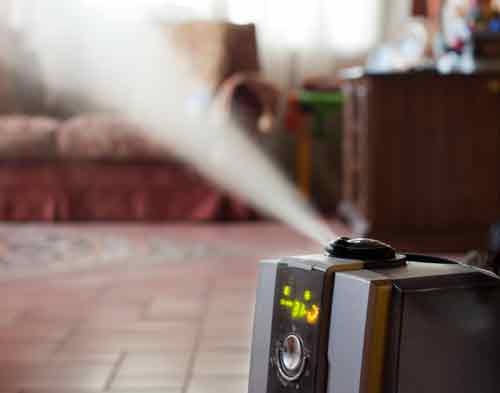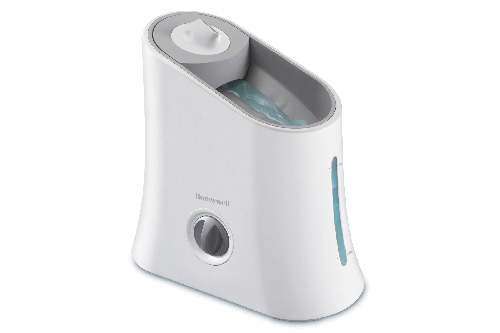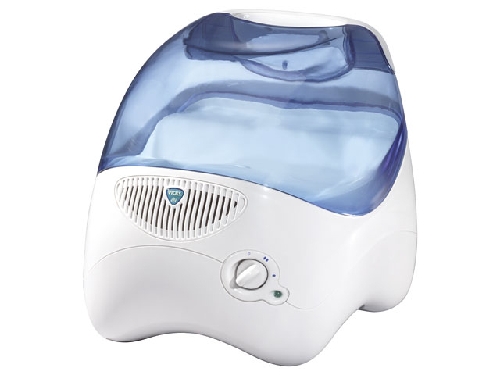Baby, it’s dry inside
Whether it's battling the summer heat or winter cold, residents of the Las Vegas Valley keep their homes closed tight - often for months - to keep the elements outside.
But running the air conditioner or heater constantly can remove precious, needed moisture from the air. And even if we complain about how sticky and miserable we get when the humidity is high during the valley's monsoon season, a lack of moisture inside our homes can cause severe cracking of our skin as well as cause damage to our homes and their contents.
"In locations like Las Vegas, the relative humidity both outdoors and indoors can be exceedingly low. In winter months outdoor humidity levels can be as low as the single digits," said Dr. Ted Myatt, a senior scientist with the independent research firm Environmental Health and Engineering and biological safety officer for Brigham and Women's Hospital in Boston.
When humidity drops to 10 percent or lower - drier than the Sahara Desert - moisture is pulled from the body creating dry eyes, noses and throats, flaky, itchy skin and chapped lips. It also takes the moisture out of wood, causing furniture and moldings to crack, and increases the amount of static electricity in the air.
The solution is simple: Get a humidifier.
"Running a humidifier can help increase the relative humidity of a room or even with the entire home, creating a more comfortable living environment," said Barb Hopkins, a home-repair expert for Repair.com.
Among the benefits of having a humidifier is the ability to breathe better. When throat and nasal passages stay hydrated, you breathe better and can sleep more comfortably as well.
"Humidifiers have traditionally been used to help alleviate cold and flu symptoms like coughs and congestion, but a study published in the peer-reviewed journal 'PLoS One' concluded that 'maintaining a high indoor relative humidity and ventilation rate may help reduce chances of influenza A virus infection,' " Myatt said.
And your house remains more livable and healthier as well.
"Humidifiers also help protect valuable wood furniture from drying out and cracking and prevent wood floors from buckling and separating. When humidity levels are extremely low, moisture is pulled from the wood furniture, antiques, et cetera."
Extremely dry air also causes paint and wallpaper to crack and can damage pianos.
A humidifier is good for your home's plants as well, said Evette Rios, a home expert and correspondent for ABC's "The Chew."
"Using a humidifier is a great way to promote the health of your house plants by helping to prevent curled leaves and dry leaf tips," Rios said.
How much relative humidity you need varies from about 40 percent to 60 percent, as suggested by the Environmental Protection Agency and Centers for Disease Control and Prevention.
You can purchase a simple indoor humidity meter to test the level of water vapor - or humidity - in your home. The meter looks and acts like a thermometer, except that it does not measure the ambient temperature. Often, you can find the two measurers packaged into one unit that costs around $10 to $20, depending on the features.
"Basic models will show a room's current humidity level and the ideal comfort level, helping you determine when to turn a humidifier on or off," Hopkins said.
She also said you should be able to tell without a meter whether your home is too dry or too moist. A lack of moisture will be evident by excessive static electricity or cracks in wood within your home. Excessive moisture can be seen as puddling on sills, condensation on the window or mold growth.
Several types and sizes of humidifiers are available, some which work specifically in one room and others that serve the entire home. As the size of the area the humidifier serves increases, so does its price, Hopkins said.
Portable, tabletop models are the most versatile and can be moved to different locations within your home, as needed. Console humidifiers can work in larger locations, such as the upper level of a home. Whole house or central units attach to a home's air conditioning/heating system and generally require professional installation.
Typically, they operate with regular tap water and have built-in filters to remove impurities so they are not released into the air.
Honeywell offers several tabletop cool-mist models. The units, which are priced from about $30, are generally easy to fill. Descriptions on the company's website say filling a unit is as easy as watering a plant. The units also have indicators for when they need to be refilled and are easy to clean - in some cases the parts are dishwasher safe.
The most inexpensive models can run for roughly 12 hours before needing to be refilled; more expensive models can run longer.
Similarly, Vicks' V3100 cool-moisture tabletop humidifier is self-regulating, adjusting as necessary to the amount of moisture in the air. It is priced around $30, has two speeds and runs for about 18 hours before needing to be refilled.
Vaporizers, which have long been used to help people sleep better, especially when used in conjunction with medicated or aromatherapy oils, are a type of humidifier that releases heated mist into the air.
Other types of humidifiers include ultrasonic and evaporative humidifiers.
When using a tabletop humidifier, Hopkins and Myatt recommend placing it on an elevated, flat surface near a return air vent to help the moisture circulate through the room. It should be kept about 6 inches from windows and walls to avoid condensation.
Hopkins also suggests that something waterproof or a thin towel should be placed under the humidifier to prevent damage to the surface underneath it.
Myatt cautions that humidifiers should be put in a location where children cannot reach them and away from heat sources such as stoves, radiators and heaters.



















